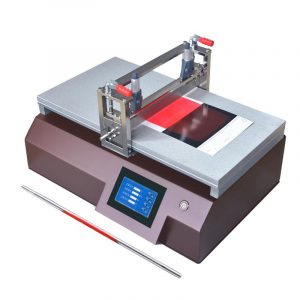Coating machine application of thermal paper preparation adhesive
Thermal paper is a special thermal sensitive material, it can be heated after the chemical reaction, so as to produce visible images or words. Thermal paper usually consists of two main parts: a substrate and a thermal layer.

1. Substrate: the substrate of thermal paper is used to support and transfer the thermal layer of the material. Common substrates include paper, plastic film, etc. The choice of substrate depends on the application requirements of thermal paper, such as the need for wear resistance, water resistance and other characteristics.
2. Thermal layer: Thermal layer is a key part of thermal paper, which contains heat-sensitive chemicals. The thermal sensitive layer is usually composed of thermal ink or thermal dye. When thermal paper is stimulated by thermal energy, the chemical substances in the thermal layer will change color or react chemically to form images or words.
Coating machine application of thermal paper preparation adhesive
3. Back adhesive layer: thermal paper is generally attached to some kind of test, so it is necessary to prepare a layer of back adhesive on the back, and the back adhesive is generally specially modulated hot melt adhesive.
How to prepare adhesive for thermal paper?
The preparation of the back adhesive of thermal paper requires certain professional equipment and materials. The following are the basic steps for general adhesive preparation:
Material preparation: Prepare the required raw materials, including rubber powder, solvent, stabilizer, etc. Select suitable materials for thermal paper applications and ensure their quality and purity.
Dissolve the rubber powder: add the rubber powder to the appropriate solvent, such as water or organic solvent, according to the formula and proportion provided by the manufacturer. According to the characteristics and solubility of rubber powder, select the appropriate solvent.
Coating machine application of thermal paper preparation adhesive
Mixing and stirring: The dissolved rubber powder and solvent are mixed together and stirred using appropriate mixing equipment to ensure that the rubber powder is completely dissolved and a uniform glue solution is formed.
Addition of stabilizers: As required, stabilizers can be added to the adhesive solution to improve the stability and viscosity of the adhesive solution and ensure its performance during preparation and use.
Filtration and defoaming: The glue is filtered through filtration equipment to remove suspended particles and impurities. At the same time, corresponding measures can be taken, such as vacuum defoaming, to eliminate the bubbles in the glue solution.
Back glue coating: evenly spread the glue on the back of the thermal paper. Use experimental automatic coating machine/roll to roll coating machine (small production) and process control to ensure that the glue is evenly and continuously coated on the surface of the paper.

Coating machine application of thermal paper preparation adhesive
Drying and curing: send the coated thermal paper into an oven or other drying equipment or use a heating type coating machine for scraping and coating can be dried at the same time after scraping and coating, in order to remove the solvent in the glue solution, so that the glue solution cures to form a back adhesive layer. According to the properties and preparation requirements of the glue solution, appropriate drying time and temperature control.
Cutting and packaging: Dry and cured thermal paper is cut and packaged to obtain the final adhesive thermal paper product. Ensure that the packaging process meets the hygiene requirements and product quality protection.
It should be noted that the above steps are only the basic process of general preparation of back glue, and the specific preparation methods and conditions may vary due to the type of rubber powder, glue solution formula and equipment requirements. In practice, the relevant manufacturer’s guidelines and process specifications should be followed according to the specific rubber powder and preparation requirements.
